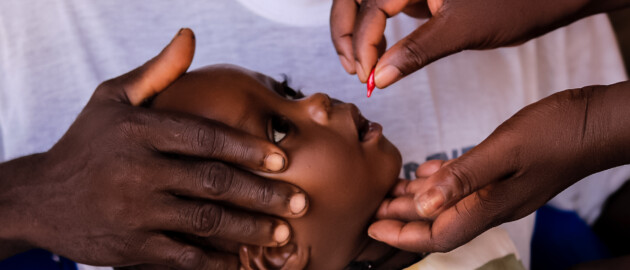Vitamin A
Improving child survival with vitamin A.
Vitamin A deficiency is the leading cause of preventable childhood blindness and increases the risk of mortality from common childhood illnesses, such as measles and diarrhoea.

Investing in nutrition to deliver global impact.
Conflict, climate change, economic downturns and the aftermath of the COVID-19 pandemic have threatened to undo years of hard-won development gains. Leveraging more than three decades of experience at the forefront of a global battle that has allowed us to redefine our impact using new delivery platforms, innovative technologies and financing models, and research and advocacy, as we forge ahead with the ultimate vision of ending all forms of malnutrition.
Download the Annual Report PDF
Welcome to Nutrition International’s 2022 annual report.
2022 was a tough year, with multiple global shocks that we are all too familiar with. What characterized our work as a team this year was seeing the nutrition opportunity within these crises.
The opportunity to engage with countries to understand the major obstacles they are facing in scaling up nutrition. The opportunity to build out our capabilities and strengthen our organization. And the opportunity to deepen our regional engagement and connect it more intentionally with national action.
This is a critical time. The world is facing many competing crises that risk diluting focus on the foundational importance of nutrition, and donor and country budgets are under heavy pressure. In recent years, there has been a strong emphasis on narratives about food, food security, starvation, hunger and treatment that have overshadowed the importance of nutrition, nutrition security and prevention. All of these are equally important, and yet we have lost focus on the most impactful pieces – on the evidence-based, low-cost, high-impact interventions that do the greatest good.
children under five received two doses of vitamin A
people gained access to adequately iodized salt
people gained access to fortified foods
children with diarrhoea received the recommended course of zinc and oral rehydration salts
adolescents received nutrition education
adolescent girls consumed weekly iron and folic acid supplements
pregnant women consumed iron and folic acid supplements
newborns reached with a birth package intervention
Creating lasting change in our core countries.
Across Africa and Asia, we deliver comprehensive initiatives from the national to local level, collaborating with governments and partners across sectors to implement policies, expand the knowledge base, and provide quality nutrition interventions. Here are just a few highlights from our work:
We support the government and other partners to deliver micronutrient supplements, adequately fortified staple foods and improved health and nutrition services, with a particular focus on women, children and girls. Some key highlights from this year include:
Ethiopia is grappling with its worst food crisis in decades due to prolonged drought, ongoing conflict and soaring food prices. We are collaborating with the government and other partners to implement impactful nutrition initiatives to improve the nutritional status of adolescent girls, women and newborns, and infants and young children. Some key highlights from this year include:
In India, essential health and nutrition services began to resume as COVID-19 cases declined. We continued to work alongside government ministries and partners to provide key nutrition interventions to address the country’s nutrition challenges and improve the health of the entire population, especially women, girls and children. Some key highlights from this year include:
We work closely with the government to ensure that nutrition policies are properly enforced and support nutrition interventions to improve the nutritional status of the population. Some key highlights from this year include:
Working alongside both national and county governments, we aim to strengthen policies and secure increased resources for nutrition programming with the goal of ensuring equitable access to essential nutrition, particularly for women, girls and children. Some key highlights from this year include:
Working in collaboration with our partners, we support the government to deliver quality nutrition programs and ensure they are available for those who need them. Some key highlights from this year include:
Pakistan faces a severe malnutrition crisis, exacerbated by the 2022 floods that devastated a third of the country. As a key partner to the government and other global partners, we remain committed to improving child, adolescent and maternal malnutrition indicators through our nutrition programs. Some key highlights from this year include:
We work with governments and partners to improve women’s and children’s nutrition in Senegal and the high-burden countries of the Sahel. Some key highlights from this year include:
We supported the government to operationalize the country’s National Multisectoral Nutrition Action Plans to ensure the right nutrition gets to those in need, particularly women, adolescent girls and children. Some key highlights from this year include:
We nourish people to nourish life.
Nutrition International has been a leader in the global fight against malnutrition for more than 30 years, reaching hundreds of millions of people with low-cost, high-impact nutrition interventions in more than 60 countries around the world.
Renowned for our world-class leadership in global nutrition, we adopt a no-missed opportunity approach, working directly with governments to strengthen their capacity, partnering with research institutions to improve guidance, and breaking down silos between different sectors to successfully integrate nutrition into non nutrition platforms. Serving as a force multiplier across the development ecosystem, our unique blend of capabilities empowers countries to overcome barriers to scaling up nutrition, domestic resource mobilization, as well as local capacity and ownership.
Nutrition International is headquartered in Ottawa, Canada with offices across Africa and Asia to oversee regional and country-level operations.